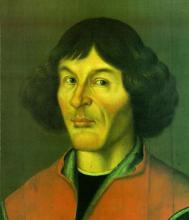History of Astronomy
Cosmology, how people thought about the heavens, was critical to successful and accurate celestial navigation.
PtolemyPtolemy, Claudius Claudius Ptolemy
c.90-168. Probably born in Egypt of Greek heritage. Mathematician, astronomer and cartographer. With simple projections created a world map which summarized geographic information of the Greco-Roman world in which he created a latitude/ longitude system to describe locations.
Read More: c. 150 CE, conceived an earth-centered model of universe.
CopernicusCopernicus, Nicholas Nicholas Copernicus
1473-1543. Polish astronomer and mathematician who developed and published the view of an Earth that orbited a stationary sun.
Read More: 1543, published the sun-centered model of the universe we now use.
KeplerKepler, Johannes Johannes Kepler
1571-1630. German astronomer and mathematician who theorized that planets and the Earth travel around the sun in elliptical orbits.
Read More: Worked out mathematically elliptical planetary orbits and published this in 1609.
GalileoGalilei, Galileo Galileo Galilei
1564-1642. Italian mathematician, astronomer and instrument maker. In 1609, basing his work on a description of a Dutch telescope, he developed the first practical telescope which he used to discover the moons of Jupiter the following year.
Read More: Created the first practical telescope in 1609 and used it to find the moons of Jupiter.
NewtonNewton, Sir Isaac Sir Isaac Newton
1643- 1727. English mathematician who laid the groundwork for calculus and did breakthrough work in optics and gravitation.
Read More: In 1687 published the laws of motion that would be used to predict locations of celestial bodies, based on Kepler’s theories.

